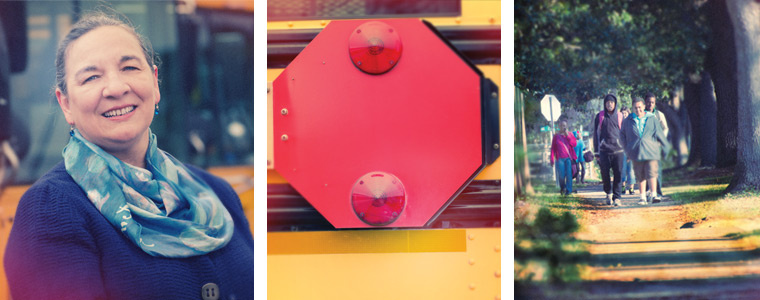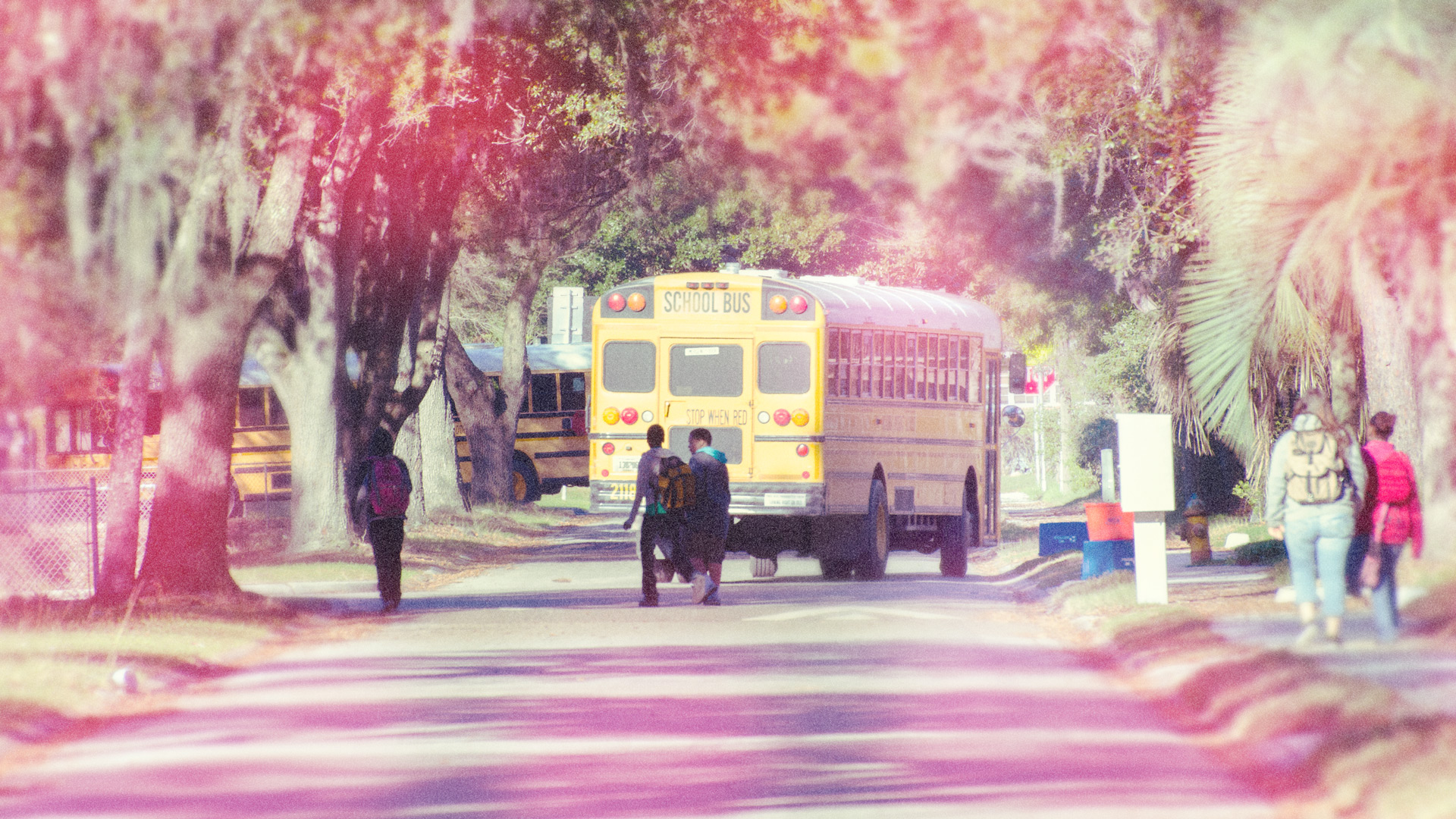The story is apocryphal, passed through generations: When I was your age, I walked five miles to school (and 10 miles back, if the storyteller really wants to pull your leg), in the snow and rain with no shoes, and…
Exaggerations aside, chances are there is a nugget of truth in the tall tale. In 1969, 48 percent of children walked to school. Of those who lived within one mile, 89 percent walked to school.
In 2009, 13 percent of children walked to school, the number increasing only to 35 percent for those within a mile.
What happened?
University of Florida urban and regional planning Professor Ruth Steiner says the choices communities have made in the last four decades about land planning have caused a cultural shift in school transportation. And that shift comes with a price.
“With schools, we really need to pay greater attention to the environment for walking, because if you don’t facilitate walking you could adversely affect the health of children,” Steiner says. “There’s also a belief logically that the habits we develop as children we carry through life, so if we don’t teach children to bicycle, for example, they may never learn to bicycle, and bicycling can be part of a healthy lifestyle as we age.”
The health benefits of walking or biking to school — what Steiner calls “active transportation” — could help in the fight against childhood obesity. A third of children born in 2000 or later may suffer from diabetes at some point in their lives, and the Centers for Disease Control and Prevention report that between one and three children between the ages of 6 and 19 are overweight or obese, with a direct cost to society of $14 billion per year.
Add to that a $21.8 billion national tab for school busing — or $443 per student — and the cost of not walking adds up.
Then imagine, Steiner says, putting even a fraction of that money into classrooms. For what it costs to bus children, each student could have an iPad, or a sturdy bicycle, or a smaller class size. Florida alone spends $935 million to bus fewer than half the state’s schoolchildren.
“Think about school buses as an investment,” Steiner says. “If you owned a business, would you buy a vehicle you used a maximum of four hours a day, nine months of the year?”
While it’s a seemingly simple decision — to walk or not to walk — a lot of factors go into it, says Steiner, director of the Center for Health and the Built Environment in the UF College of Design, Construction and Planning. The center examines the connection between how we build communities and the health of the people who live in those communities.
Suburban development patterns — sprawl — including neighborhoods with plenty of streets ending in cul-de-sacs but few sidewalks, discourage walking and biking, and often are not well connected to the activities of daily life, like grocery stores.
“It turns out that the way we have been designing our cities is not healthy for us,” Steiner says. “Travel to school can be an important piece of physical activity.”
The potential to get children walking and biking to school again piqued the interest of the Robert Wood Johnson Foundation, which funded Steiner’s initial research into how school siting affects travel to school. Researchers had been studying the correlation between children’s activity and health, and Steiner’s work showed that school locations affect the decision to walk. The federal Safe Routes to School program started in 2005 and uses $629 million in funding to improve the safety of roads and build sidewalks near schools, while promoting community involvement. After five years of the program, a study in five states found that walking increased 45 percent and biking 24 percent.
The decision to walk or bike depends on where schools are located, where people live and the number of children who live in neighborhoods near schools.
Steiner has collected examples from across the state of school siting gone wrong (see opposite page).
Intangible factors also come into play. The first missing children photos showed up on milk cartons in 1984, heightening fears of stranger danger. A vicious cycle also comes into play: traffic around a school may cause a parent to drive a child rather than allowing her to walk, but multiple parents making that decision is what creates the traffic around the school. In most communities, the drive to and from school accounts for 15 percent to 25 percent of peak hour traffic, Steiner says.
When local planners, school planners and transportation planners all work together, Steiner says, “We get the golden apple of the school that is well integrated into the community with opportunity for children to walk.”
Schools are too important to the life of a community to be relegated to leftover parcels of land donated by a developer or the cheapest land available, Steiner says. Established school sites, too, offer opportunities for planning.
“We are building schools all the time even as we are closing other schools,” Steiner says. “Neighborhoods will go through periods where there’s a very low census of children around a school, but that doesn’t mean children won’t be there in the future.”
Instead of closing schools in an enrollment slump, Steiner says districts could follow a model in New York City, where such schools are repurposed as community or senior centers, until the surrounding neighborhood cycles back into one with children.

“Once we close a school, we actually can leave a big hole in the community,” Steiner says. “And we have to be mindful that we are not just making an investment for 40 years, we may be making an investment for 100 years. Stable neighborhoods will go through cycles.
“What if you stay with a school? You might actually be able to make the neighborhood come back faster,” Steiner says. “Communities can decide to value public resources, and schools are one of those resources.”
Active transportation plays a big role in New Urbanism, a land planning and design movement that started in the late 1980s to promote walkable neighborhoods, with jobs, shopping, restaurants and public facilities such as schools all within walking distance of homes.
In contrast, in many communities today, Steiner says, the rules are biased in favor of an automobile-centric, suburban style of development.
“Unless we change the conversation, the incentives or the regulations we are going to continue to design in this same way, and we’re going to get the same results we’ve always had,” Steiner says.
“Think how often you see a sidewalk or a bike lane and then it stops. We would never do that to automobile drivers but we do it to bicyclists and pedestrians all the time.
“I’ve come to believe that there is a certain part of public policy that assumes that sprawl is a foregone conclusion.”
Some studies indicate that creating a space conducive to walking also creates opportunities for people to get to know their neighbors. Just because more people are walking doesn’t necessarily lead to more community, Steiner says, but it does lead to better health.
“People will walk anywhere they have to, but in places where it is easier to walk, you’re more likely to see people walking,” Steiner says.
There are equity issues, too. Often, the poor walk because they have to, the wealthy because they choose to.
Still, walking, whether to reach a destination or for recreation, is part of a health habit, Steiner says, and one that could be grounded in simply walking to school.
“If we look at the full cost of school transportation, we aren’t accounting for the lifelong habits that would be developed if we found a way to design our schools and integrate them more centrally within our community, where children could walk to school.”
At centrally located schools, children often will walk or bike. That’s the experience of Mike Gamble, principal of Howard Bishop Middle School in Gainesville, which has several child-filled neighborhoods nearby. He estimates about 40 percent of students that are not bused to the magnet program walk to school. Getting a sidewalk this school year helped. The students already were walking, but the sidewalks make it a safer trip.
Although Gamble, an avid cyclist, bikes to school, he says few of his students do because they don’t own bicycles. Those who do bike sometimes forget their locks, but they know they can stash their bikes in his office.
“We want to promote biking and activity,” Gamble says. “We open up the gym in the morning. We’re all about getting the kids moving.”
Steiner says a rule of thumb in transportation planning is that people give little thought to walking a quarter of a mile. In malls, for instance, the distance between anchor stores generally is a quarter mile.
One mile is the distance at which people start to think about driving, although it is only a 20-minute walk. Many parents wait longer in drop-off and pickup lines.
Communities can change that, though. Walking school buses and bicycle trains work in many neighborhoods, with parents handing off the task of chaperoning block by block or taking turns different days of the week.
“Everybody has a reason for why they don’t want to walk their children to school,” Steiner says, “but with schools allocating less time for exercise in the school day, that makes it even more important to start and end the day with exercise.”
Source:
- Ruth Steiner, Center for Health and the Built Environment
This article was originally featured in the Spring 2014 issue of Explore Magazine.

